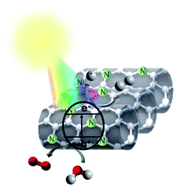Band gap alignment of structured microporous graphitic carbons by N doping and its influence on photocatalytic overall water splitting†
Abstract
Hydrogen generation from water using solar light could be a process of paramount importance in the forthcoming decarbonized society. This reaction requires efficient photocatalysts based on earth-abundant elements. Metal-free carbon semiconducting materials are very appealing in this regard. This manuscript shows that N-doping is a convenient strategy to increase the photocatalytic activity of microporous graphitic carbons obtained from the pyrolysis of α-, β- and γ-cyclodextrins. These (N)C carbons exhibit enhanced photocatalytic activity for H2 generation in the presence of methanol with respect to their undoped analogs. The optimal (N)C material (pore size, 0.65 nm) was the one derived from α-cyclodextrin at a N content of 3.1%, achieving a H2 productivity of 1.8 mmol g−1 at 4 h in the presence of methanol. These materials also exhibit photocatalytic activity for overall water splitting, although with lower efficiency than for H2 generation in the presence of sacrificial electron donors. The present results illustrate the tuning of band alignment by N-doping in the graphitic matrix.



 Please wait while we load your content...
Please wait while we load your content...